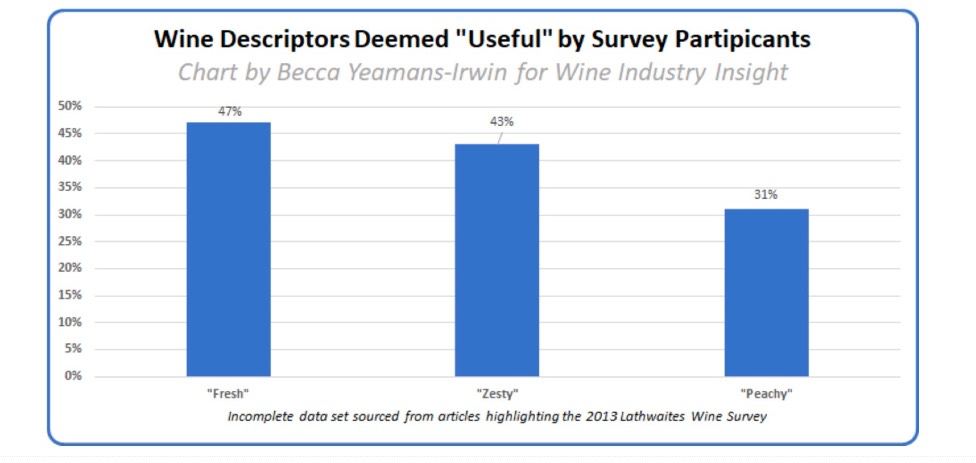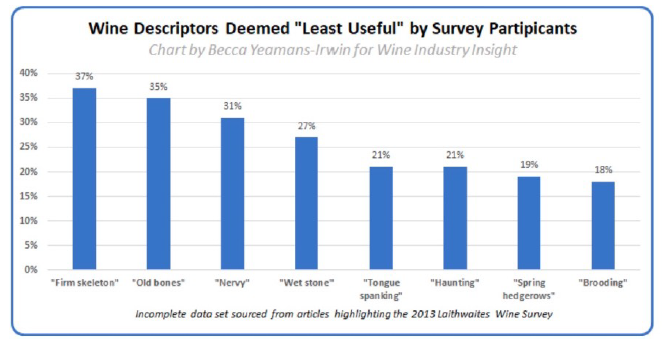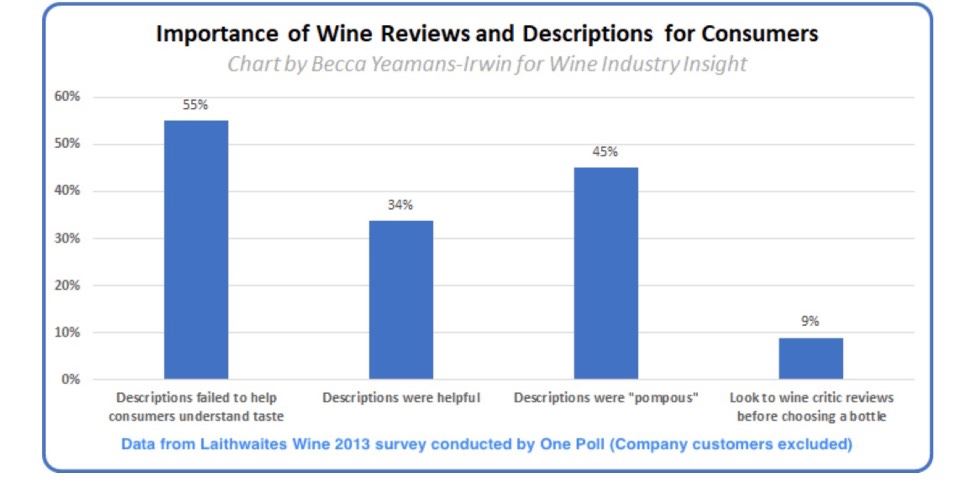The Demise in Popularity of Critical Wine Score Pronouncements
“Have you ever wondered what it might be like if wines scored humans….or decided to score wine
critics? Would wines be more sympathetic to us than we are to them?”
Ron Washam, HMW, HoseMaster of Wine™
The 100-point scoring system has been the standard way to rate wines used by nearly all wine
publications since its introduction by Robert Parker, Jr. in 1983. At the time Parker introduced his
scoring system, wine quality standards were nowhere near what they are today. As a result, it is rare
to find a wine today that deserves a score below 80, resulting in essentially a 20-point rating system
that has little range to differentiate wines because of compression of scores around 90 points.
The vast majority of domestic Pinot Noir wines over the past several vintages fall in the 87-93 point
range as judged by many wine publication reviewers. In essence, this range becomes the “average,”
with scores at or below 86 becoming below average and scores of 93 and above considered above
average, even outstanding or extraordinary.
In the October 15, 2018 issue of the Wine Spectator, 739 California Pinot Noirs, mostly from the 2015
vintage was rated for the report. The range of scores was 81-95. The average score for all rated
wines was 88.5.
The Wine Enthusiast website reports that 2,024 domestic Pinot Noirs were reviewed and scored
through October in 2018. The range of scores was 80-99. The number of scores in each numerical
range was as follows: 98+ 4, 94-97 223, 90-93 1,115, 87-89 535, 83-86 141, 80-82 6. 78% of the
wines fell into the approximate “average” range of 87-93.
The inflation of scoring over the past several years has been recognized by many. This trend has
diluted the value of a 90 point score which has, in essence, become “average.” When this score
inflation is combined with the compression of the scoring range, the result is that more wines are
pushed into the 92-96 point range, even though they might not be worthy of such praise judged by
past standards.
A review of all my wine scores for domestic Pinot Noir published in the PinotFile from 2013 to 2018
indicated a slight increase over this six-year interval. Here are the averages of all scores for each
year: 2013-89.6, 2014-90.4, 2015-90.2, 2016-90.7, 2017-91.0, and 2018-91.3. It should be noted that
the sample of domestic Pinot Noir wines I am offered for review is skewed and predominantly fall in
the premium or ultra-premium category. For example, in 2018, all Pinot Noir wines that scored 90 or
above in the PinotFile had an average price per bottle of $56.00.
Measurable differences between a rating of say 89 or 90 are vague, but the distinction between a
score of 89 and 90 holds considerable significance for both the wine’s producer and the consumer. 90
is the acknowledged threshold below which a wine is considered very good yet more challenging to
attract a market. A score of 90 indicates a significant step up in perceived quality and desirability and
can be more successfully promoted.
There are multiple drawbacks to the 100-point scoring system. Its interpretation is not consistent and
nearly every wine critic utilizes the 100-point rating system differently. The result is that the scores are
not strictly comparable from one wine critic to another.
A recent article in Food & Wine, www.foodandwine.com/wine/wine-critics, titled “In Their Own
Words, This Is How Seven Professional Wine Writers and Critics Go About Rating a Bottle,” confirmed
the highly variable approach wine reviewers use to arrive at a wine’s score.
Grading has become an estimation of a wine’s overall quality without specific points assigned to color,
aroma, flavor, texture and finish that was Parker’s original intent for the 100-point scoring system.
Scoring is highly subjective, often based on personal taste, pleasure and emotion with many wine
critics not giving credit to estimated age ability (although admittedly this is highly speculative in most
cases anyway).
David Morrison, who pens The Wine Gourd at www.winegourdblogspot.com, looked at the poor
mathematics of wine quality scores. He pointed out, “Most wine commentators’ wine-quality scores
are personal to themselves. That is, the best we can expect from each commentator is that their wine
scores can be compared among themselves so that we can work out which wines they liked and
which ones they didn’t. However, the scores cannot be compared between commentators at all. Wine
assessment is no better using numbers than words because the numbers violate many of the
mathematical requirements for a precise language.”
Tom Wark, an American wine blogger and respected wine commentator posting at
www.fermentationwineblog.com, similarly noted, “The thing is, I’m not aware of any wine reviewer
using ratings who claim that the number they attach to their written review is the result of a strict
equation or a form of mathematical logic. It is, rather, a way for them to express their appreciation of a
wine relative to other wines.”
Leading French wine critic Michael Bettane has recently weighed in on the subject of wine scoring. He
notes, “An absolute score serves only to flatter the self-esteem of wealthy buyers….while the rest of
us must surf the top-scoring options in search of wines within our price range.” He concludes, “A
whole bunch of arithmetic scores is not the way to educate consumers about wine. What we critics
have to do is teach people to compare their tasting sensibilities with our own….to discover what they
like or what they are seeking based on the reviews we provide.”
It is challenging for a consumer to align himself with the palate of a wine critic because everyone has
a different sense of smell and taste is primarily determined by smell. About 90% of taste comes from
odor receptors that are genetically determined. According to a study reported in Nature Genetics in
May 2003, no two individual genotypes for smell perception are the same. In this study, 189 people
were genotyped and none of them had the same odor-related genes and thus lacked the same set of
odor receptors.
The Wine Market Council reported a study in 2017 that found Millennials (anyone born from 1980 to
2000) drank 42% of all wine in the U.S. in 2015, more than any other age group. These wine
consumers and I have two sons in this age group, could care less about wine scores and only know
about wine criticism because that is what I do. One of my sons told me, “My generation doesn’t know the name of one wine critic. We know a few writers for magazines through Instagram and that is about
it. We rely on friends for wine recommendations, but we also drink a lot of beer and spirits. No one
has the attention span to care about wine journalism, much less wine scores.” A high percentage of
millennial wine consumers now use social media such as Instagram and wine apps to find wine
suggestions and to post their wine experiences.
It is not just Millennials that are turning less often to ratings. A study by Sonoma State University in
2018 revealed the purchasing habits of the American wine consumer: www.winebusiness.com/
news/?go=getArticle&dataId=207060. 1,191 American wine consumers from 50 states were
surveyed. 2 percent were Generation Z (ages 21-23), 26 percent were Millennials (ages 24-38), 27
percent were Gen Xers (ages 39-53), 47 percent were Boomers (ages 54-74) and 7 percent were
Greatest Generation (ages 75+). When asked about decision making when purchasing wine, price
(80 percent) and brand (69 percent) were most important, with ratings a distant fifth (23 percent).
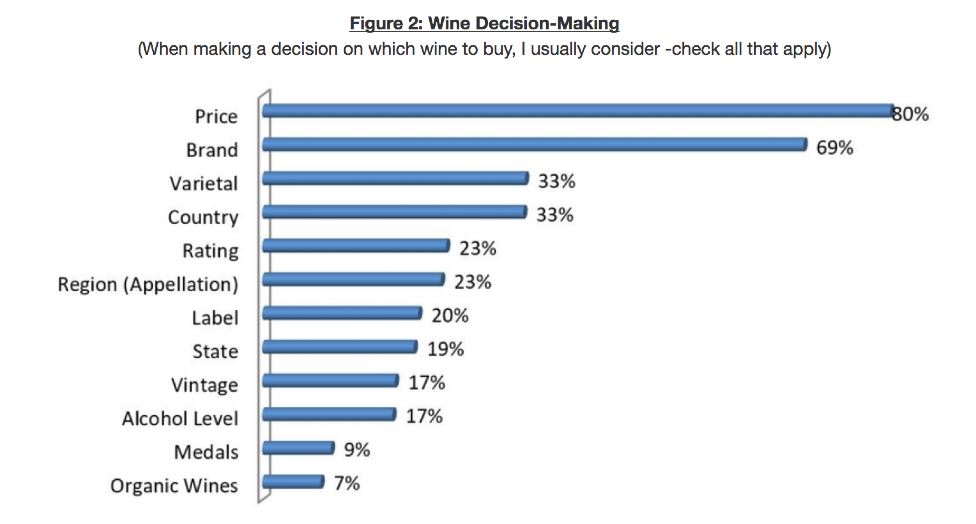
Some astute wine consumers look closely at the descriptors in a wine review and find it of paramount
importance relative to the score. The description of the wine seems of greater usefulness especially if
the reader can see “between the lines,” and understands certain words or phrases that the writer uses
that are a tip-off indicating a special wine.
Wine descriptions would seem to be of most value to well-informed wine consumers, while others less
knowledgeable about wine look more to scores for guidance. As a writer and certified sommelier Katie
Finn noted, “Scores act like life vests to shoppers drowning in a sea of options. The idea is that
scores help people paralyzed with the fear of buying the ‘wrong’ wine.”
David Morrison pens The Wine Gourd at www.winegourd.blogspot.com and points out, “Word
descriptions of wine are frequently disparaged because it is often rather difficult to work out what all of
this flowery language is supposed to mean. This dissatisfaction is one reason why wine-quality scores
are popular because mathematics is supposed to make communication pedantically precise.”
Justin Howard-Sneyd, a Master of Wine has said, “Describing wine is not an exact science; wine and
taste are very personal and subjective. A wine that I think tastes of cherry, could taste totally different
to someone else, so it’s no wonder that there is such a vast variety of language when it comes to wine
descriptions.”
Some descriptors are simply more useful than others. The charts below are from the 2013 Lathwaites
Wine Survey in which those taking part said they were relatively well-informed on wine terminology.
The first two charts show wine descriptors that are deemed “useful” and “least useful.” The third chart
reveals research that shows 55% of consumers found descriptions of no help in understanding taste
and 45% of the descriptions were considered “pompous.” Asked why the descriptions were not helpful,
responses included finding them meaningless, bearing no relationship to a wine’s taste, pretentious
and “a load of poppycock.”
The following charts were obtained from Daily News Fetch created by Wine Industry Insight, Lewis Perdue, Editor and Publisher, at www.industryinsight.com.
A common failing of wine scoring relates to wine reviews that don’t criticize wines or explain why they
give a wine a low score. Here is a recent wine review from Wine Spectator for a wine that received a
score of 87: “Wild sage, dark red cherry and turned earth show on the familiar nose of this bottling.
The palate is even-handed with red fruit and chaparral flavors.” If you only read the description of the
wine, what could you possibly discern about its quality or relate the description to the score?
There is one drawback to professional wine reviews and not specifically to wine scoring that has to do
with orthonasal versus retronasal perception of odors. Wine critics use a regime of sniffing, sipping
and spitting but this orthonasal perception falls short of overall taste perception. Consumers swallow
and experience an additional taste/smell sensation known as retronasal perception of odors whereby
odors are perceived when they enter the nose through the pharynx in swallowing. A 2012 article in
Physiology & Behavior, www.ncbi.nim.nih.gov/pubmed/22425641, on the retronasal perception of
odors, pointed out that orthonasal and retronasal olfaction pathways convey two distinct sensory
signals. The full perception of wine is based on the interaction between orthonasal and retronasal
smell, taste and texture.
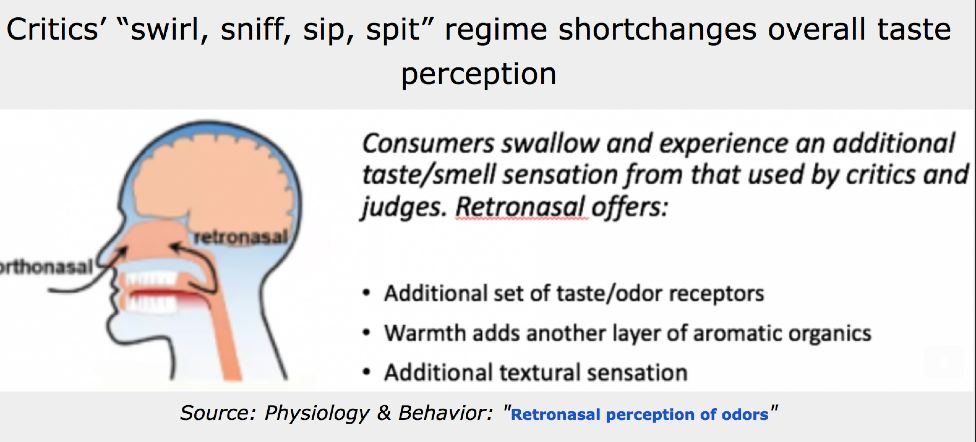
This is why I often taste wines in the morning with spitting and then re-taste some wines in the late
afternoon with a swallow. I believe this is rarely done by wine tasting professionals.
The 100-point scoring system clearly has many drawbacks but it has been and continues to be the
main driving force that sells wine. “Amazing Scores for Our 2016 Vintage Wines” reads the marketing
tagline for many wineries at this time of the year. The higher the score, the more retailers reference
them, the more wineries promote them, and the more influential the review becomes. Discrepancies
abound, however, with retailers known to quote scores for wines from a previous vintage or promote
lofty scores that lack attribution. Scores are hollow numbers if not used in conjunction with the score
assignor. Some sources quote scores from the Robert Parker Wine Advocate that the consumer may
still attribute to Robert Parker, Jr., yet he is only one of nine reviewers for the Robert Parker Wine
Advocate.
I have come to the realization that the current wine rating system may have outlived its usefulness. I
am not alone. Noted wine writer, Jamie Goode, said two years ago, “The 100-point scale is very
compressed at the top end….and this scale is becoming so bunched at the top end that it is nearing
the end of its useful life.”
Maybe we have reached the point that scores are no longer of any value to the current generation of
wine consumers in making purchasing decisions. Dwight Furrow, writing at www.3quarksdaily.com
on the purpose of wine criticism recently noted, “I almost never read wine reviews prior to purchasing.
I don’t need them for that purpose. I do read them after tasting the wine to learn more about what I’m
tasting. But also I like to check my impressions against others who have tasted the wine because it
teaches me something about my own palate and preferences.”
Recently, the Chinese have launched a wine rating system based on Chinese tastes that is aimed at
evaluating imported and domestically produced wines. As reported in November 2018 in The Drinks
Business, www.thedrinksbusiness.com/2018/11/china-launches-its-own-wine-rating-system/,
the Chinese wine rating system evaluates wines mainly based on color, aroma, palate and body using
a scoring scale of 10 points. The rating system is said to reflect China’s unique culinary traditions and
preferences. Apparently, a panel of judges consisting of members of the China Alcoholic Drinks
Association (CADA) and the China Wine & Viticulture Technology Association will do the ratings that
could lead to a national wine recommendation system. This critical wine reviewing system is not
revolutionary in that the 10-point rating system is simply another numerically-based scoring program.
George Vierra, who writes at www.georgevierrawinemaking.blogspot.com, described the Napa Valley College 25-Point Scorecard. This scoring system objectively analyzes wine's appearance, odor and taste for a total final score of a possible 25 points, and also includes a "Final Praises" section that includes further notes on wine style, ageing, food serving suggestions, price, value and where the wine can be purchased. My criticism of this scoring system is that it is but another variation of a mathematically-based scoring program and because it is based on 25 points, would only lead to challenges for the wine consumer to reconcile it with the 20-point and 100-point scoring systems.
So what to do with a wine rating system that may have outlived its usefulness and is of little interest to
the younger generation wine consumer?How can a new rating system be devised that won’t
invalidate the 35 years of published ratings based on the 100-point system? Can we create a wine
review with a noble calling, one that offers useful distinctions and criticism than one simply based on a
highly subjective and personal numerical award? Can we corral all the important professional wine
reviewers who are notoriously independent and have them use a standard review format that would
be truly comparable?




